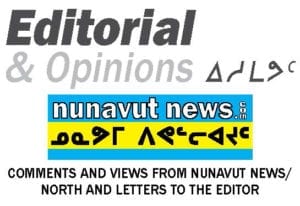 We are pleased – yet appalled – to see the Auditor General confirm some of our strongest theories about Nunavut's education system in its report to the Nunavut legislative assembly earlier this month. The report, titled Support for High School Students and Adult Learners, shows the system breaks when students are most vulnerable to failure – at the end, when students are either close to graduation or worse, if they try to complete their high school education when adults.
We are pleased – yet appalled – to see the Auditor General confirm some of our strongest theories about Nunavut's education system in its report to the Nunavut legislative assembly earlier this month. The report, titled Support for High School Students and Adult Learners, shows the system breaks when students are most vulnerable to failure – at the end, when students are either close to graduation or worse, if they try to complete their high school education when adults.
The note that 52 per cent of Inuit aged 25 to 64 – so working age – have a high school diploma is worrying. You can bet that most of those folks are gainfully employed, and many of them working in government.
The other 48 per cent of that group stand next to no chance of getting a white-collar government job, and many likely struggle to move to new jobs because of that simple distinction so often seen in job advertisements. In the era of automated human resources management, they stand next to no chance.
Second, many schools lack guidance counsellors and are failing to meet their mandated requirement to develop career and program plans. This ties in to the ongoing teacher shortage, which is aggravated by the fact most Canadian jurisdictions are also facing shortages. As schools struggle with this staffing crunch, students are the ones losing out.
For those whose parents are high school graduates or, even better, post-secondary graduates, the likelihood of graduating and visualizing a path post-graduation is much easier. Even without support from the schools, these youth are far more likely to succeed. For those who are the first to graduate high school, it's a real accomplishment. But then what? Those who don't have a teacher ready to mentor and support them as de facto guidance counsellors are much less likely to make and execute a plan.
Based on the auditor's report, if you drop out and try to come back, 'good luck' is all we can say.
This may sound flippant, but the statistics are clear: of the 286 adult learners accepted into the PASS (Pathways to Adult Secondary School Graduation) program between fall 2016 and fall 2018, only nine graduated. It takes 100 credits to graduate, and most had fewer than 65 credits.
In addition, the infrastructure does not exist to support success for adult learners, with only eight communities offering the Adult Basic Education program, and only four offering it three times a year. For those without a high school diploma, this program is the key that opens the door to programs at Nunavut Arctic College.
The message is clear: the Nunavut government is not serious about seeing Inuit – already learning in a colonial system taught mostly (especially at the high school level) by non-Inuit speaking English – reach the level of education we expect for all of our children.
As a result, there is no chance the government can fulfill the promise of a representative Inuit employment as outlined in Article 23 of the Nunavut Agreement.
The only path forward is to look outside of the system for support. We must come together as parents and communities – through mentoring, tutoring, and career guidance –to help our youth graduate.